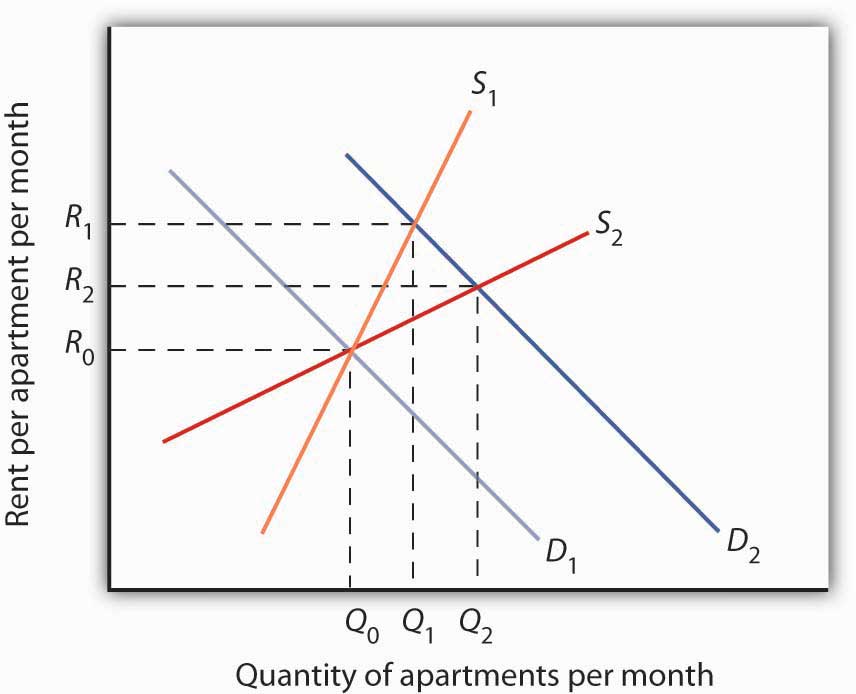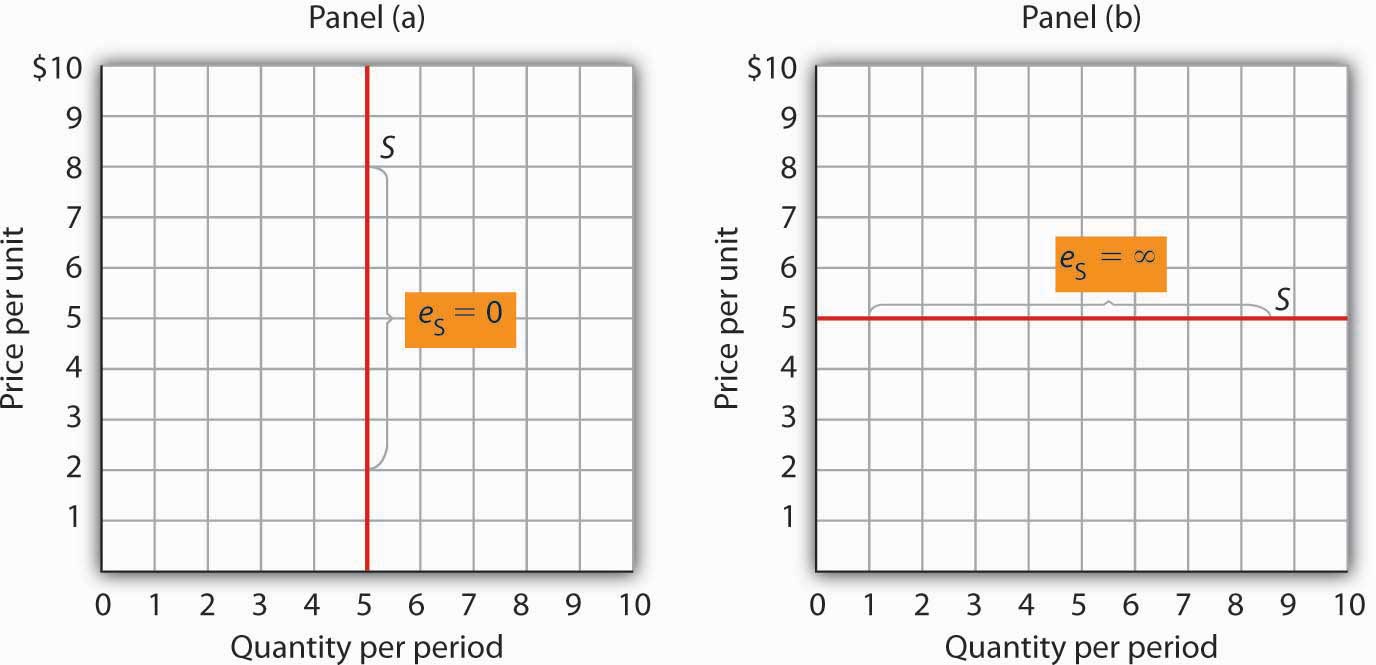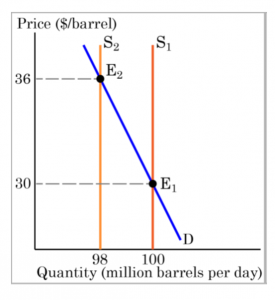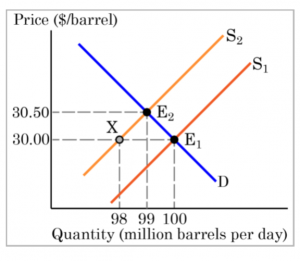If the Price Elasticity of Demand for Beef Is 1.6
25 Price Elasticity of Supply
Learning Objectives
- Explicate the concept of elasticity of supply and its adding.
- Explain what it means for supply to be price inelastic, unit price rubberband, price elastic, perfectly price inelastic, and perfectly toll elastic.
- Explain why time is an of import determinant of cost elasticity of supply.
- Use the concept of toll elasticity of supply to the labor supply curve.
The elasticity measures encountered so far in this chapter all chronicle to the demand side of the market. It is likewise useful to know how responsive quantity supplied is to a change in price.
Suppose the need for apartments rises. There will be a shortage of apartments at the onetime level of apartment rents and pressure on rents to rise. All other things unchanged, the more responsive the quantity of apartments supplied is to changes in monthly rents, the lower the increase in rent required to eliminate the shortage and to bring the market back to equilibrium. Conversely, if quantity supplied is less responsive to cost changes, price will have to rise more to eliminate a shortage caused by an increase in need.
This is illustrated in Figure 3.10 "Increase in Apartment Rents Depends on How Responsive Supply Is". Suppose the hire for a typical apartment had been R 0 and the quantity Q 0 when the demand curve was D 1 and the supply curve was either Due south 1 (a supply curve in which quantity supplied is less responsive to price changes) or Due south ii (a supply bend in which quantity supplied is more than responsive to price changes). Note that with either supply curve, equilibrium toll and quantity are initially the same. Now suppose that demand increases to D 2, perhaps due to population growth. With supply bend S 1, the price (hire in this example) volition ascension to R 1 and the quantity of apartments will rise to Q 1. If, however, the supply curve had been S two, the rent would only have to rise to R two to bring the market back to equilibrium. In addition, the new equilibrium number of apartments would be higher at Q 2. Supply curve S 2 shows greater responsiveness of quantity supplied to price alter than does supply curve Southward 1.
Figure 3.10 Increment in Apartment Rents Depends on How Responsive Supply Is

The more than responsive the supply of apartments is to changes in price (rent in this instance), the less rents rise when the need for apartments increases.
Nosotros mensurate the price elasticity of supply (due eastSouth ) as the ratio of the percentage modify in quantity supplied of a good or service to the percentage change in its cost, all other things unchanged:
Equation 3.5
[latex]e_S = \frac{ \% \: change \: in \: quantity \: supplied}{ \% \: modify \: in \: price}[/latex]
Because price and quantity supplied usually motion in the same direction, the price elasticity of supply is unremarkably positive. The larger the price elasticity of supply, the more responsive the firms that supply the adept or service are to a cost modify.
Supply is price elastic if the toll elasticity of supply is greater than 1, unit toll rubberband if it is equal to ane, and price inelastic if information technology is less than 1. A vertical supply curve, every bit shown in Panel (a) of Figure three.11 "Supply Curves and Their Cost Elasticities", is perfectly inelastic; its price elasticity of supply is zero. The supply of Beatles' songs is perfectly inelastic because the ring no longer exists. A horizontal supply bend, as shown in Panel (b) of Figure 3.11 "Supply Curves and Their Price Elasticities", is perfectly elastic; its cost elasticity of supply is infinite. Information technology means that suppliers are willing to supply any amount at a certain price.
Figure three.11 Supply Curves and Their Price Elasticities

The supply curve in Panel (a) is perfectly inelastic. In Panel (b), the supply curve is perfectly rubberband.
Time: An Important Determinant of the Elasticity of Supply
Time plays a very important office in the determination of the price elasticity of supply. Await once again at the event of rent increases on the supply of apartments. Suppose apartment rents in a city rise. If we are looking at a supply curve of apartments over a flow of a few months, the rent increase is likely to induce apartment owners to hire out a relatively small number of additional apartments. With the higher rents, apartment owners may exist more vigorous in reducing their vacancy rates, and, indeed, with more than people looking for apartments to rent, this should be adequately easy to accomplish. Attics and basements are piece of cake to renovate and rent out as additional units. In a brusk period of fourth dimension, even so, the supply response is probable to be fairly small, implying that the toll elasticity of supply is fairly low. A supply bend corresponding to a short catamenia of fourth dimension would look like S 1 in Figure 5.10 "Increase in Apartment Rents Depends on How Responsive Supply Is". It is during such periods that there may be calls for rent controls.
If the period of fourth dimension under consideration is a few years rather than a few months, the supply bend is likely to be much more price elastic. Over fourth dimension, buildings tin can be converted from other uses and new apartment complexes can be built. A supply curve corresponding to a longer flow of time would await like S 2 in Figure 5.10 "Increase in Flat Rents Depends on How Responsive Supply Is".
Elasticity of Labor Supply: A Special Application
The concept of price elasticity of supply tin can exist applied to labor to bear witness how the quantity of labor supplied responds to changes in wages or salaries. What makes this example interesting is that it has sometimes been constitute that the measured elasticity is negative, that is, that an increase in the wage rate is associated with a reduction in the quantity of labor supplied.
In virtually cases, labor supply curves take their normal up slope: higher wages induce people to work more. For them, having the boosted income from working more is preferable to having more than leisure time. However, wage increases may lead some people in very highly paid jobs to cut dorsum on the number of hours they piece of work because their incomes are already high and they would rather accept more time for leisure activities. In this case, the labor supply curve would have a negative gradient. The reasons for this phenomenon are explained more fully in a later affiliate.
This chapter has covered a variety of elasticity measures. All report the degree to which a dependent variable responds to a change in an independent variable. As we have seen, the degree of this response tin can play a critically important role in determining the outcomes of a wide range of economic events. Table 3.ii "Selected Elasticity Estimates"1 provides examples of some estimates of elasticities.
Tabular array 3.2 Selected Elasticity Estimates
| Product | Elasticity | Product | Elasticity | Production | Elasticity |
|---|---|---|---|---|---|
| Price Elasticity of Demand | Cross Cost Elasticity of Demand | Income Elasticity of Demand | |||
| Crude oil (U.S.)* | −0.06 | Booze with respect to toll of heroin | −0.05 | Speeding citations | −0.26 to −0.33 |
| Gasoline | −0.ane | Fuel with respect to price of transport | −0.48 | Urban Public Trust in French republic and Madrid (respectively) | −0.23; −0.26 |
| Speeding citations | −0.21 | Alcohol with respect to price of food | −0.16 | Footing beef | −0.197 |
| Cabbage | −0.25 | Marijuana with respect to price of heroin (similar for cocaine) | −0.01 | Lottery instant game sales in Colorado | −0.06 |
| Cocaine (ii estimates) | −0.28; −one.0 | Beer with respect to price of wine distilled liquor (immature drinkers) | 0.0 | Heroin | −0.00 |
| Alcohol | −0.30 | Beer with respect to price of distilled liquor (young drinkers) | 0.0 | Marijuana, alcohol, cocaine | +0.00 |
| Peaches | −0.38 | Pork with respect to price of poultry | 0.06 | Potatoes | 0.xv |
| Marijuana | −0.four | Pork with respect to price of ground beef | 0.23 | Nutrient** | 0.2 |
| Cigarettes (all smokers; two estimates) | −0.4; −0.32 | Ground beef with respect to price of poultry | 0.24 | Wearable*** | 0.3 |
| Crude oil (U.S.)** | −0.45 | Ground beef with respect to price of pork | 0.35 | Beer | 0.iv |
| Milk (two estimates) | −0.49; −0.63 | Coke with respect to price of Pepsi | 0.61 | Eggs | 0.57 |
| Gasoline (intermediate term) | −0.5 | Pepsi with respect to price of Coke | 0.80 | Coke | 0.lx |
| Soft drinks | −0.55 | Local television advert with respect to toll of radio ad | 1.0 | Shelter** | 0.seven |
| Transportation* | −0.half dozen | Smokeless tobacco with respect to toll of cigarettes (young males) | 1.2 | Beef (table cuts—not footing) | 0.81 |
| Food | −0.seven | Toll Elasticity of Supply | Oranges | 0.83 | |
| Beer | −0.7 to −0.9 | Physicians (Specialist) | −0.three | Apples | i.32 |
| Cigarettes (teenagers; two estimates) | −0.9 to −1.5 | Physicians (Master Care) | 0.0 | Leisure** | 1.iv |
| Heroin | −0.94 | Physicians (Young male) | 0.2 | Peaches | 1.43 |
| Ground beef | −ane.0 | Physicians (Young female) | 0.5 | Wellness care** | i.6 |
| Cottage cheese | −i.one | Milk* | 0.36 | Higher teaching | 1.67 |
| Gasoline** | −i.5 | Milk** | 0.5 | ||
| Coke | −ane.71 | Child care labor | ii | ||
| Transportation | −1.nine | ||||
| Pepsi | −2.08 | ||||
| Fresh tomatoes | −two.22 | ||||
| Food** | −two.3 | ||||
| Lettuce | −2.58 | ||||
| Notation: *=short-run; **=long-run | |||||
Key Takeaways
- The price elasticity of supply measures the responsiveness of quantity supplied to changes in price. It is the percentage change in quantity supplied divided past the percentage change in price. It is ordinarily positive.
- Supply is price inelastic if the toll elasticity of supply is less than one; it is unit price elastic if the price elasticity of supply is equal to 1; and it is cost elastic if the toll elasticity of supply is greater than 1. A vertical supply curve is said to be perfectly inelastic. A horizontal supply curve is said to be perfectly elastic.
- The price elasticity of supply is greater when the length of time nether consideration is longer considering over fourth dimension producers have more options for adjusting to the change in price.
- When applied to labor supply, the price elasticity of supply is ordinarily positive but can be negative. If higher wages induce people to work more than, the labor supply bend is upward sloping and the cost elasticity of supply is positive. In some very loftier-paying professions, the labor supply curve may have a negative slope, which leads to a negative cost elasticity of supply.
Try It!
In the tardily 1990s, it was reported on the news that the high-tech industry was worried near being able to find plenty workers with reckoner-related expertise. Chore offers for recent college graduates with degrees in computer science went with loftier salaries. It was also reported that more undergraduates than ever were majoring in figurer science. Compare the price elasticity of supply of computer scientists at that indicate in fourth dimension to the price elasticity of supply of computer scientists over a longer catamenia of, say, 1999 to 2009.
Case in Signal: Oil Prices Revisited
WTI Crude Oil Spot price
Think from our discussion of the dynamics of the world oil prices earlier in Chapter 2 that in early 2016, the world toll of oil roughshod to almost $30 per barrel. In this situation, the OPEC countries, which were losing their revenue from oil sales, faced a tough choice: cut their oil production to prop upward the price, as they've washed in the past, or maintain their output and let the price continue to fall with the purpose of driving the producers of the more costly shale oil out of the market. As we could see, OPEC decided not just to go with the latter choice, simply increase their oil production substantially. What we've learned above about the price elasticities of demand and supply will aid us better sympathize why OPEC made that decision.
Let's come across what would take happened had OPEC decided to cut its oil product instead of increasing information technology. Suppose OPEC is making its decision when the cost of oil has fallen to $30 and the world pro-duction of oil is 100 million barrels per twenty-four hours. OPEC accounts for nearly twoscore% of the world oil product, i.e. produces 40 million barrels per day, so its total revenue from oil is $thirty×twoscore million = $one,200 million or $1.ii billion. Will OPEC exist able to increase its oil revenue if information technology reduces its production target past, say, v%, to boost the price?
Let'southward first consider what will happen in a very short run, when other countries don't accept enough time to increment their oil production. Effigy v.xiii illustrates this situation. The world market place is initially in equilibrium at point E1, where the price of oil is $xxx per barrel and 100 million barrels per day is supplied. In the very curt run, the supply of oil is practically perfectly inelastic; that is, the supply curve is vertical.

Figure three.12
If OPEC cuts its oil production past 5% (i.eastward. by forty one thousand thousand × 0.05 = 2 1000000 barrels per mean solar day), the world production will decrease from 100 1000000 to 98 million barrels per day. That is, the OPEC's product cutting will shift the supply curve from S1 to S2, and then the market will move along the demand curve (D) from the initial equilibrium, E1, to a new equilibrium, E2, where the price is college.
We can predict what the new price of oil volition be given that the curt-run price elasticity of demand for oil is estimated at −0.ane. Since the percentage change in quantity is −2% (using the conventional formula, %ΔQ = (98 – 100)/100 = −0.02 or −2%), we can write:
[latex]e_S = \frac{ \% \: change \: in \: quantity \: supplied}{ \% \: alter \: in \: price}[/latex]
[latex]{-0.1} = \frac{ {-2{\%}} }{ \% \: change \: in \: price}[/latex]
Solving this equation for %ΔP, we get:
-0.ane x %ΔP = -2%
[latex]{{\%}{\Delta}P} = \frac{ {-2{\%}} }{ {-0.one}}[/latex]
= 20%
That is, the cost rises by $thirty×0.2 = $6, from $30 to $36.
Since OPEC is now selling 38 million barrels of oil at $36 per barrel, its total revenue is $36×38 million = $i,368 million. This is $168 million or fourteen% more than the revenue OPEC received before the oil production cut. Thus, by reducing
its oil production OPEC was able to boost the price of oil, which increased its total revenue from oil sales. This should come up as no surprise. As we've learned in this affiliate, when the need is price inelastic, raising the toll increases
total revenue. And when the demand is very price inelastic (which is the instance hither), even small reductions in quantity tin can lead to substantial price hikes and total revenue gains. This, withal, is simply true if the competition does not influence the market place quantity supplied.
And in the case of the present day's globe market for oil, that could be truthful in a very curt run, only not in a longer run.
Let's encounter how the world market place for oil will answer to OPEC's production cuts in a longer run, when other countries—including such major globe oil producers as the United states of america and Russia—increase their production of oil in response to a higher price. As we know, both demand and supply are more price elastic in the long run than in the short run. Figure 5. 14 shows what happens if the world supply of oil is nonetheless inelastic, but no longer perfectly inelastic (say, ES = 0.2) and the demand for oil becomes less inelastic (say, ED = −0.2).

Figure three.13
At present, when OPEC reduces its product of oil past ii meg barrels shifting the world supply bend from S1 to S2, as in Figure three.26, other oil producers reply to the initial backlog demand for oil and a higher price resulting from it by increasing their product, which partly compensates the OPEC's reduced supply. The market moves forth the supply curve S2 from point X to the new equilibrium at point E2, where the price of oil is $xxx.50 per butt and the quantity is 99 million barrels per day. As you lot can see, because both demand and supply are now less toll inelastic, the price rises simply by $1.50 (five%). Will the OPEC'due south total acquirement from oil notwithstanding increment? Notation first that since other countries increase their oil production while the OPEC countries reduce theirs, the OPEC's market place share decreases from 40% to 38.iv% (as OPEC is at present producing 38 million barrels per day out of the total world production of 99 meg barrels per twenty-four hour period). The OPEC's full revenue then is $30.fifty×38 one thousand thousand = $i,159 million, which is 3.4% less than its revenue before the production cut ($1,200 one thousand thousand). Of course, in an even longer run, when both demand and supply are fifty-fifty more elastic, OPEC's oil production cuts to prop up the price volition result in fifty-fifty greater losses of their oil revenues.
Source: Ogloblin, Constantin; Brown, John; King, John; and Levernier, William, "Microeconomics for Business" (2018).Business organisation Assistants, Management, and Economic science Open Textbooks. 6.
Answer to Try It! Problem
While at a point in time the supply of people with degrees in computer science is very toll inelastic, over time the elasticity should ascent. That more students were majoring in informatics lends credence to this prediction. As supply becomes more price elastic, salaries in this field should rise more slowly.
oneAlthough close to zero in all cases, the significant and positive signs of income elasticity for marijuana, alcohol, and cocaine suggest that they are normal goods, but significant and negative signs, in the case of heroin, propose that heroin is an inferior good. Saffer and Chaloupka (cited beneath) suggest the effects of income for all 4 substances might be affected by education. [Other References listed beneath]
References
Adesoji, O. Adelaja, A. "Price Changes, Supply Elasticities, Manufacture System, and Dairy Output Distribution," American Periodical of Agricultural Economics 73:1 (February 1991):89–102.
Bar-Ilan, A., and Bruce Sacerdote, "The Response of Criminals and Non-Criminals to Fines," Journal of Law and Economic science, 47:one (April 2004): 1–17.
Baye, M.R., D.W. Jansen, and J.W. Lee, "Advertising Furnishings in Complete Demand Systems," Applied Economics 24 (1992):1087–1096.
Bhuyan, S., and Rigoberto A. Lopez, "Oligopoly Power in the Food and Tobacco Industries," American Journal of Agricultural Economic science 79 (August 1997):1035–1043.
Blau, D. Thousand., "The Supply of Child Intendance Labor," Journal of Labor Economics 2(11) (April 1993):324–347.
Blundell, R., et al., "What Do Nosotros Learn Almost Consumer Demand Patterns from Micro Data?", American Economic Review 83(three) (June 1993):570–597.
Bresson, G., Joyce Dargay, Jean-Loup Madre, and Alain Pirotte, "Economical and Structural Determinants of the Demand for French Send: An Analysis on a Panel of French Urban Areas Using Shrinkage Estimators," Transportation Research: Function A 38:4 (May 2004): 269–285.
Brester, G. Westward., and Michael K. Wohlgenant, "Estimating Interrelated Demands for Meats Using New Measures for Basis and Table Cut Beef," American Journal of Agricultural Economics 73 (November 1991):1182–1194.
Chocolate-brown, D. M., "The Rise Price of Physicians' Services: A Correction and Extension on Supply," Review of Economics and Statistics 76(2) (May 1994):389–393.
Davis, M. C., and Michael K. Wohlgenant, "Demand Elasticities from a Detached Pick Model: The Natural Christmas Tree Market," Periodical of Agricultural Economics 75(iii) (August 1993):730–738.
Ekelund, R. B., S. Ford, and John D. Jackson. "Are Local TV Markets Separate Markets?" International Journal of the Economics of Business seven:1 (2000): 79–97.
Elzinga, Yard. Thou., "Beer," in Walter Adams and James Brock, eds., The Structure of American Industry, 9th ed. (Englewood Cliffs: Prentice Hall, 1995), pp. 119–151.
Farrelly, Chiliad. C., Terry F. Pechacek, and Frank J. Chaloupka; "The Impact of Tobacco Control Program Expenditures on Aggregate Cigarette Sales: 1981–2000," Periodical of Health Economics 22:5 (September 2003): 843–859.
Fogel, R. West., "Communicable Upward With the Economy," American Economic Review 89(i) (March, 1999):i–21.
Gasmi, F., et al., "Econometric Analysis of Collusive Behavior in a Soft-Potable Market," Journal of Economics and Direction Strategy (Summertime 1992), pp. 277–311.
Griffin, J. M., and Henry B. Steele, Energy Economics and Policy (New York: Bookish Press, 1980), p. 232.
Grossman, 1000., "A Survey of Economic Models of Addictive Behavior," Journal of Drug Issues 28:3 (Summertime 1998):631–643.
Grossman, M., "Cigarette Taxes," Public Wellness Reports 112:4 (July/August 1997): 290–297.
Grossman, Thousand., and Henry Saffer, "Beer Taxes, the Legal Drinking Age, and Youth Motor Vehicle Fatalities," Journal of Legal Studies 16(2) (June 1987):351–374.
Hansen, A., "The Tax Incidence of the Colorado State Lottery Instant Game," Public Finance Quarterly 23(3) (July, 1995):385–398.
Heien, D., and Cathy Roheim Wessells, "The Demand for Dairy Products: Construction, Prediction, and Decomposition," American Journal of Agriculture Economics (May 1988):219–228.
Kleinman, One thousand. A. R., Marijuana: Costs of Abuse, Costs of Command (NY:Greenwood Press, 1989).
Levine, J. K., et al., "The Need for College Education in Iii Mid-Atlantic States," New York Economic Review 18 (Autumn 1988):three–20.
Matas, A., "Demand and Revenue Implications of an Integrated Transport Policy: The Example of Madrid," Ship Reviews, 24:2 (March 2004): 195–217.
Rizzo J. A., and David Blumenthal, "Physician Labor Supply: Practice Income Effects Matter?" Journal of Wellness Economics 13(4) (December 1994):433–453.
Ross, H., and Frank J. Chaloupka, "The Effect of Public Policies and Prices on Youth Smoking," Southern Economic Journal 70:4 (Apr 2004): 796–815.
Saffer, H., and Frank Chaloupka, "The Need for Illicit Drugs," Economic Inquiry 37(iii) (July, 1999): 401–411.
Suits, D. B., "Agriculture," in Walter Adams and James Brock, eds., The Structure of American Industry, nineth ed. (Englewood Cliffs: Prentice Hall, , 1995), pp. 1–33.
Tauras. J. A., "Public Policy and Smoking Cessation among Young Adults in the United states of america," Health Policy, 68:3 (June 2004): 321–332.
Source: https://uw.pressbooks.pub/microman/chapter/3-5-price-elasticity-of-supply/
0 Response to "If the Price Elasticity of Demand for Beef Is 1.6"
Postar um comentário